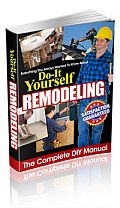Welcome to Ceilings Guide
Texturing Your Ceiling Article

Texturing Your Ceiling
from:The look of your ceiling is every bit as important as the way your floors or walls appear. The color and texturing of the ceiling can completely alter the look and feel of any room. Ceilings are a great place to flex your remodeling muscles. There are so many colors, textures and strategies available for you to use.
Many people choose textured ceiling strategies. They are a great way mask flaws, curvatures and drywall seams. They can also add an element of ornamentation to what could otherwise be a plain ceiling. Textured interact interestingly with light and can also have the advantage of muffling sounds, especially when acoustical texturing applications are used. The difference between a plain and a textured ceiling in terms of appearance is immeasurable. The addition of texture to a ceiling can completely change a room.
The actual materials used to produce textured ceilings are easy to create. It generally involves little more than mixing paint with other readily-available materials. You can find a variety of texturing “muds” at any hardware or interior design store.
As with so many elements of remodeling, ceilings are a “practice makes perfect” project. You might get lucky on your first try and produce a fantastic ceiling. Your best bet, however, is to practice before you actually commit to applying a texture. You can try your hand at texturing by practicing on scrap drywall or plywood. After you’re sure you have just the right plan for your ceiling, you can get to work.
Here are a few suggestions for texturing your ceiling.
First, you might want to try a pattern with a texturing brush. You’ll want to use a ceiling material that’s a little thicker than paint but that isn’t as thick as the mud you’d use for a drywall job. For this texture, you can use a roller brush. However, you don’t really roll it on. Instead, you “stamp” it to the ceiling. After applying a first coat and allowing it to begin to set, you go over it again, using the same technique.
Second, you can produce skip trowel effect. This pattern utilizing sand and dry wall mud. You mix the two together until it’s nice and thick. With this approach, you apply relatively light pressure. This allows your tool to skip over the material. After you’ve applied the mud/sand combo, you can go over it again (lightly) with the trowel.
Third, you can use a wallpaper or other heavy duty brush to create a circular pattern. You’ll want a fairly thick, but brushable, texturing product for this method. First, apply the texture using a roller. Then, go back over it, using your brush to create a series of circles. The end result is a series of attractive swirls.
As mentioned, there is a great deal of room for creativity with ceiling texture. Try using different brush, brooms, and other materials to create an effect that appeals to you. Play with color and adjust the consistency of your texturing product to assess different possibilities.
If you’re trying to breathe a little life into a room or are mounting an all-out remodeling project, don’t neglect your ceilings. Specifically, don’t overlook the possibility of producing a gorgeous effect with a textured ceiling.



